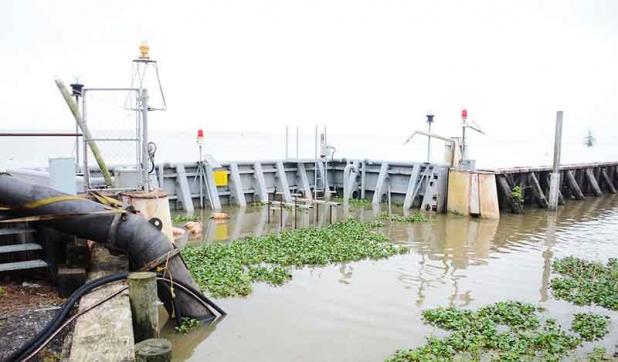
The Daily Review/Geoff Stoute
The Walnut Canal barge gate protects Lakeside Subdivision from Lake Palourde flood water.
From the Editor: Was Lakeside flood barge closed at right time?
Did the newly consolidated Drainage District No. 2A wait too long to close the Walnut Canal barge gate and protect Lakeside Subdivision from the effects of Tuesday’s 10-inch downpour?
There has already been some debate on that topic, and you can expect more.
The question was raised at Wednesday’s St. Mary Parish Council meeting by Morgan City Mayor Lee Dragna. Actually, Dragna started to raise it before his addition to the agenda was blocked by Councilman Craig Mathews, who said the matter should be left to the drainage district.
The gate had been closed earlier Wednesday as Lake Palourde’s level rose.
As he left the courthouse, Dragna said the gate should have been closed earlier. He handed me an engineering report to support his claim. And he talked about using his power as mayor to keep the gate closed, even to the point of tossing someone in jail.
Dragna served for years as chairman of the old Drainage District No. 2 board before the district was merged with the one serving Amelia. So you have to believe he has some knowledge about the subject.
The judgment depends largely on measures of the Lake Palourde level. My story on the Parish Council meeting may have added more confusion than clarity to that point. The confusion comes from the fact that the lake’s level is measured in at least two different ways.
The report offered by Dragna was written in 2015 by the T. Baker Smith Engineering firm for what was then Gravity Drainage No. 2 in the Morgan City area. The report is called “Walnut Canal Barge Gate Operational Analysis and Future Improvements.”
The report is half an inch thick. But the meaty part suggests that when the lake level reaches 1.25 feet, a staff member should notify the board chairman. When the lake reaches 1.50 feet, the weather should be monitored closely, and consideration should be given to closing the barge at that point based on weather and Atchafalaya River forecasts and on whether the resources will be available.
Closing the gate takes a couple of hours and requires a diver to check a seal.
In any case, the report said, the barge should be closed when the lake hits 1.75 feet.
Now then: If you follow the link in the report to a U.S. Army Corps of Engineers website with a graph of recent lake levels, that graph has the lake level between 3 and 5 feet for the last week or so.
So closing the gate was a slam dunk, right?
Maybe. Maybe not.
The level cited in the Smith report — the one that talks about 1.25-1.75 feet — is adjusted to reflect the North American Vertical Datum of 1988, or NAVD 88.
NAVD 88 “consists of a leveling network on the North American Continent, ranging from Alaska, through Canada, across the United States, affixed to a single origin point on the continent,” according to the National Oceanic and Atmospheric Administration.
In other words, someone wants 1.75 feet to mean the same thing in British Columbia that it means at Lake End Park.
Did I mention this is a federal government thing?
The reading that had the lake at 3-5 feet is on a different scale. It’s the one you’re probably familiar with from National Weather Service readings of levels at Lake Palourde and the Atchafalaya River.
You can make a rough conversion to NAVD 88 by subtracting 2.17 from the National Weather Service readings. Using that method, here’s what the Lake Palourde level did last week:
—The lake was at 1.79 feet (by the NAVD 88 reading) March 19. It stayed close to that level through the weekend and into Monday.
—At 1 a.m. Tuesday, before the 10-inch storm, the lake was at 1.85 feet but dropped a bit to 1.64 feet by 8 a.m. Tuesday.
—At 10 p.m. Tuesday, the rain had pushed the lake to 2.62 feet.
—By 5 a.m. Wednesday, the day the gate was closed, the lake was at 2.48 feet.
—At 6 a.m. Friday, the level was at 2.68 feet.
So there it is. The lake level was at a level that might have justified closing the gate for days before the storm, if the Smith reports recommendations are to be followed. But the level was below the close-the-gate level when the rain started falling.
You pays your money, and you makes your choice.
More weather
Mother Nature wasn’t through with the South after Tuesday’s deluge.
Tornadoes touched down in Mississippi, Georgia and Alabama overnight. The north Alabama tornado that touched down in Calhoun County is being blamed for five deaths.
It turns out that at least one tornado was associated with Tuesday’s storm. The National Weather Service confirmed that an EF-1 tornado touched down in Washington in northern St. Landry Parish.
There were no reports of injuries, but power was knocked out in a large area, and media accounts say the wind ripped the roof from a Washington home.
EF-1 tornadoes have winds of 73-112 mph.
Bill Decker is managing editor of The Daily Review.
